
views
Assessing Your Brakes

Flip your bike upside down or set it in a bike stand. When you adjust your bicycle’s disc brakes, the wheel should be elevated off of the ground so it can spin freely. If you have a bike stand, put your bike in the stand so it’s held in place and elevated off the ground. If you do not have a bike stand, just flip your bike upside down so that the seat and handlebars are on the ground and the wheels are sticking up. Portable bike stands are sold at most sporting goods stores. They typically cost between $35–50 USD.
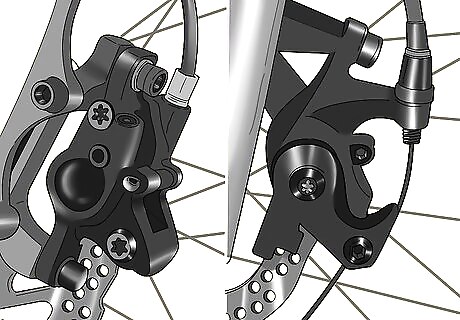
Figure out which style of disc brakes you have. Look closely at the caliper at the center of each of your bicycle’s wheels. If the bike’s calipers have a small cable running to them, they are mechanical. If the calipers don’t have any attached cables, they’re hydraulic. If you’re still not sure which style you have, snap a photo of your bike’s brakes and take it to a local cycling shop. The caliper looks like a small box about 3 inches (7.6 cm) long that sandwiches the rotor. The caliper is the mechanical device that puts pressure on the rotor and slows down your bicycle.
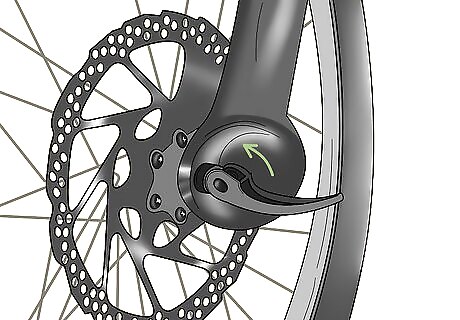
Tighten your wheel in the drop house before adjusting the brakes. A bike’s drop house is the y-shaped frame that the wheel sits between. The drop house attaches to both sides of the wheel and keeps it connected to the bike. Make sure that the wheel is firmly in place by turning the lever on the side of the wheel clockwise. Once you’ve tightened the wheel, fold the lever in until it’s flush with the wheel. On some older styles of bike, you may need to tighten the wheel in the drop house manually with an Allen wrench.
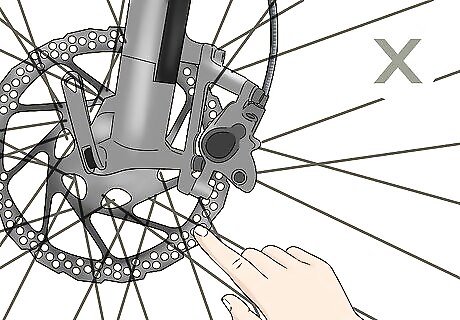
Avoid touching the edge of the rotor so you don’t cut yourself. The rotor (the circular metal disc that disc brakes apply force to) can be very sharp. As you’re adjusting your disc brakes, try not to touch the edge of the disc. Hold the disc by placing your thumb and fingers on the disc’s 2 flat sides. If you do get a cut, stop and wash it with soap. Bandage the small wound before you finish adjusting the brakes.
Adjusting Hydraulic Brakes
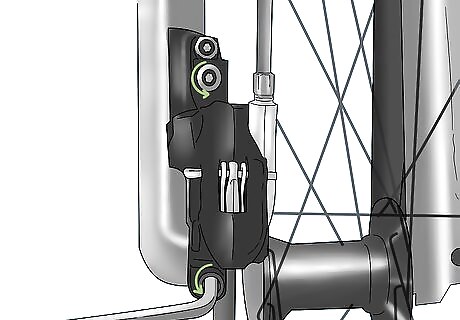
Loosen the 2 bolts on the side of your caliper if the brakes rub. If you can hear your disc brakes rubbing as you drive your bike around, it’s a sign that the brakes are too tight. Inspect the caliper and find both of the ⁄8 inch (0.32 cm) hex bolts that hold the caliper to the frame. Insert an Allen wrench of the corresponding size and twist it a half turn counterclockwise. This should loosen the brakes enough that they stop rubbing. It’s possible that the disc brakes are too tight on only 1 wheel. In this case, you will not need to tighten the brake on your other wheel.
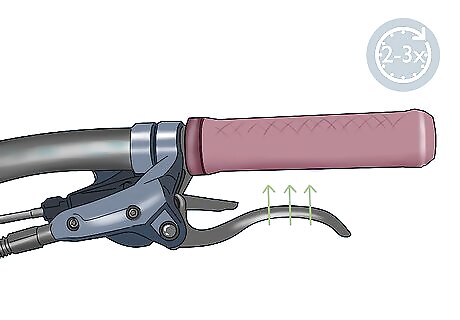
Squeeze the brake lever 2–3 times to center the caliper on the rotor. After you’ve loosened the 2 hex bolts, squeeze the brake lever that corresponds with the wheel you’re adjusting. If you bumped the caliper while you were loosening it, this will re-center it on the rotor disc. On the last squeeze, keep pressure on the brake lever. The right-hand brake lever controls the rear brake and the left-hand brake lever controls the front brake.
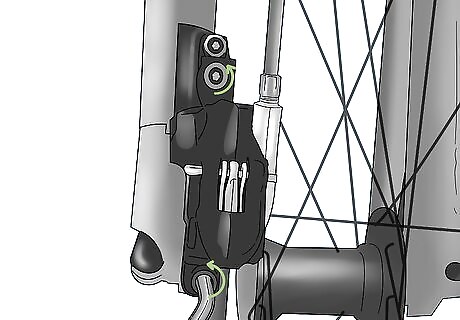
Tighten the bolts by a half turn before releasing the lever. With the corresponding brake lever held down, again insert the Allen wrench into 1 of the 2 hex bolts. This time, turn the wrench a half turn clockwise to tighten the caliper around the rotor. Tighten the second hex bolts as well. If you need to work on both the front and rear brakes at the same time, have a friend hold the brake levers while you work on the calipers.

Spin the wheel to make sure that the rubbing has stopped. Make sure that the wheel is unimpeded and can turn freely. Give the wheel a firm spin (in either direction). Listen for the sound of rubbing. If the disc brakes no longer rub, you’ve adjusted them successfully!
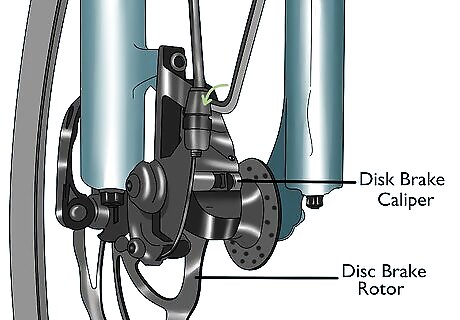
Align the caliper visually over the rotor if the brakes still rub. If the brakes continue to rub, loosen the bolts by a quarter turn. Look down from the top of the caliper and visually align it so that it sits directly over the rotor. With the brake lever held down, fine tune the position of the caliper so that it’s fully centered. Then, tighten the hex bolts a quarter turn. Again test the brakes by spinning the wheel and listening for the sound of rubbing brakes.
Tweaking Mechanical Brakes
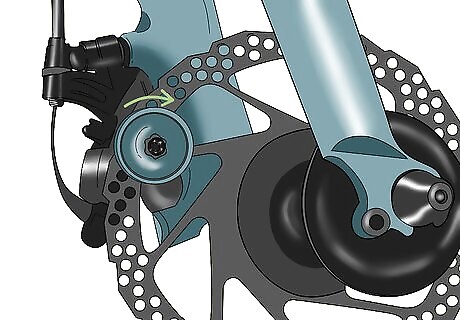
Loosen the small set screw found on the side of the caliper. Some models of mechanical disc brakes have a small “set” screw that clamps down on the caliper’s adjustment dial to prevent it from loosening while you’re riding the bike around. Use a small Philips head screwdriver to turn the set screw 1–2 full rotations counterclockwise. Not all bikes with mechanical disc brakes have a set screw on the caliper. If yours doesn’t, you can skip this step.
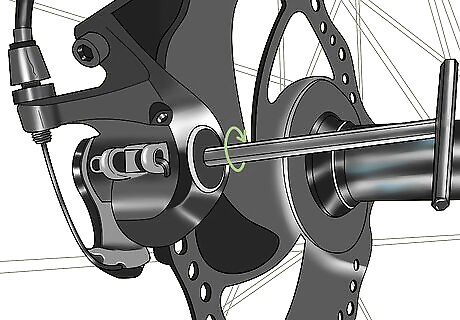
Twist the adjustment dial on the side of the caliper to adjust the brakes. Most bikes with mechanical disc brakes have a 1 inch (2.5 cm) wide plastic dial on the side of the caliper (right next to the wheel’s spokes). Turn the wheel clockwise to move the brake pad closer to the rotor and counterclockwise to move it farther away from the rotor. In some cases, bikes with mechanical disc brakes may not have an adjustment dial on the side of the caliper. In this case, there will be a hex bolt on the caliper that fills the same function.
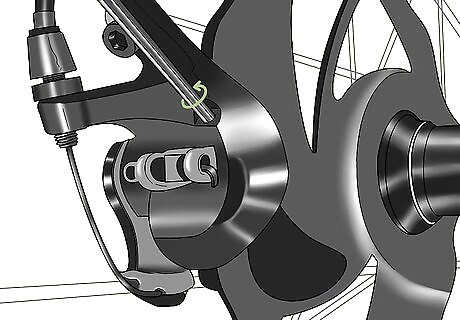
Adjust the dial until the caliper is centered directly over the metal rotor. It typically takes some fiddling to line the caliper so it’s centered over the rotor. Periodically give the bike’s wheel a spin and visually inspect the brake pad so that you can tell if the pad is rubbing on the disc brake. Most rotors aren’t perfectly flat, so don’t worry if you see a small amount of wobble as the rotor spins.
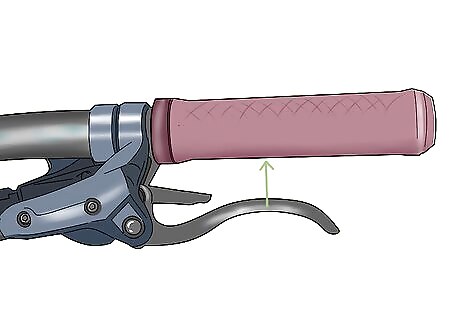
Squeeze the brake lever to make sure that the brakes tighten. Give the lever that corresponds to the brake that you’re adjusting a firm squeeze. The 2 pads should tighten on either side of the rotor. Both of the pads should touch the rotor disc at the same time; if 1 touches before the other, the rotor isn’t properly centered beneath the caliper. The right-hand brake lever works the rear brake, and the left-hand brake lever works the front brake.
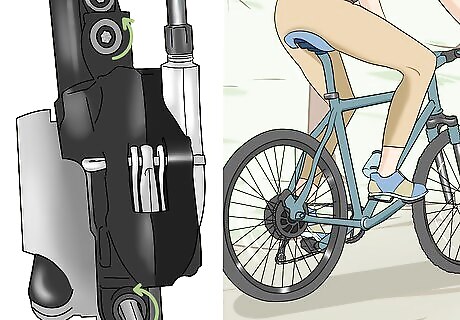
Tighten the hex bolts and the set screw before riding your bike. Use your Allen wrench to turn the 2 hex nuts on the side of the caliper clockwise. Even if you didn’t loosen them when you were adjusting your mechanical disc brakes, check to make sure that the hex bolts are tight. Also use your screwdriver to tighten the small set screw that you loosened earlier. Once you’ve tightened the bolts, the bike should be ready to ride!




















Comments
0 comment